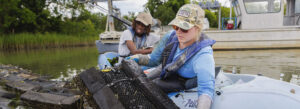RAFT partnership fortifies towns against storm hazards by turning ideas into action
It was one of those freak storms: A summer afternoon downpour in Cape Charles, five inches of rain in several hours that overloaded the system and left flooding in its wake. Water pooled along several streets downtown, stranding the cars that tried to drive through the water. One small four-door dubbed the “floating blue car,” tried to power through the flooding unsuccessfully.
“That became a shorthand for the bad flooding days in Cape Charles,” says Larry DiRe, town planner of Cape Charles. “That floating car was an acute event with critical impacts for our town. What if those events happen every summer instead of every three or four years?”
This isn’t just a question for Cape Charles. Along the Eastern Shore of Virginia, sea level rise is three to four times the global average, and the southern Chesapeake Bay region is a hotspot of sea level rise, threatening the very existence of some communities.
Enter The RAFT: Resilience Adaptation Feasibility Tool for coastal counties, cities, and towns in Virginia. The RAFT is an interdisciplinary collaboration between Old Dominion University-Virginia Sea Grant Climate Adaptation and Resilience Program, the Virginia Coastal Policy Center at William & Mary Law School (VCPC), and the University of Virginia’s Institute for Environmental Negotiation.
The RAFT partners provide a three-step process for improving coastal resilience in communities: 1) develop a customized scorecard to identify strengths and areas where the community can improve resilience to coastal storm hazards; 2) develop a task list through a community workshop; and 3) put the plan into action, with a year of assistance from The RAFT core team.
“That implementation piece was what was missing from other scorecards, report cards, or assessments,” says Angela King, assistant director of VCPC. “It was fine and good to tell a locality how they were doing on something, but if you’re not there to offer solutions or work with them on solutions, it falls flat after that process.”
While The RAFT has assessed seven localities this summer, Cape Charles was the first of three pilot communities to complete the scorecard and workshop steps over the last year—and the community is close to completing the third step as well.
In general, the scorecard identifies economic, environmental, and social factors related to resilience and rates the community in these categories. To complete the scorecard, graduate students at the University of Virginia School of Law and the College of William & Mary Law School conduct research. The students receive clarification and resolve information gaps through discussions with community staff. Once the scorecard assessment is finalized, community members come together in a workshop to identify what resilience actions can most easily be accomplished within a year.
Along the Eastern Shore of Virginia, sea level rise is three to four times the global average, and the southern Chesapeake Bay region is a hotspot of sea level rise, threatening the very existence of some communities.
It was one of those freak storms: A summer afternoon downpour in Cape Charles, five inches of rain in several hours that overloaded the system and left flooding in its wake.
For Cape Charles, about a dozen townspeople came together for the June 2017 workshop to brainstorm in small groups. The list of items to work on included education efforts such as a museum display and a website FAQ about resilience.
“We’ve done some good work, and I do believe people are more aware now than they were,” says Tracy Outten, the assistant town clerk for Cape Charles. “It was great—we had a lot of people come out, and we had a lot of good questions too.”
Since the workshop, representatives from Cape Charles stayed in touch with The RAFT core team, checking in and coordinating efforts. Two items on their list were to write a plan to reduce road flooding in the historic district and improve management of the local sand dunes. The community reached out to The RAFT.
“Our students looked through state code and looked to what other towns of this size are doing and provided some guidance,” King says.
However, the process also uncovered issues that affect multiple towns. As Hank Mayer, a Cape Charles resident, points out, some of these needs extend beyond the reach of a single town.
“Everything related to the roads, which means the infrastructure and the storm water system underneath it, too, is controlled by VDOT,” he says.
To address far-reaching concerns like these, The RAFT team is planning a regional workshop to bring state and local representatives together to coordinate on regional issues such as storm water management and infrastructure.
“We’re hoping with this regional approach, there are some things we can ask for as a region and get from the state,” says Michelle Covi, Associate Professor of Practice through the Virginia Sea Grant Climate Adaptation and Resilience Program at Old Dominion University. With the improved method of RAFT, Covi says, “I think we’ve got a better product now that we’re taking out to the Eastern Shore.”
Takeaways:
- Each coastal community has different strengths and faces unique flooding issues.
- The RAFT tool identifies areas for improvement, adapts to community feedback, and provides a plan for communities to manage their flood risk.
- The RAFT core team works with the town for a year to assist them with completing their plan to improve resiliency.
Photos and video by Aileen Devlin | Virginia Sea Grant
Story by Madeleine Jepsen | Virginia Sea Grant
Published Aug. 9, 2018.
The RAFT team is planning a regional workshop to bring state and local representatives together to coordinate on regional issues such as storm water management and infrastructure.





